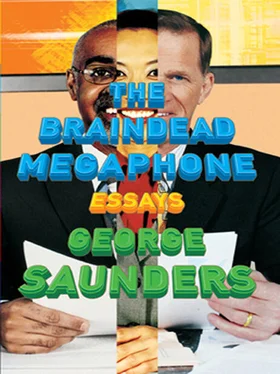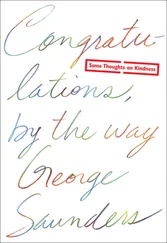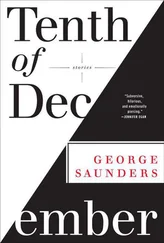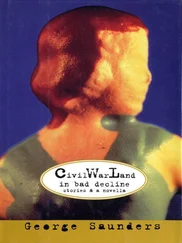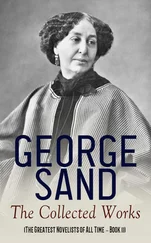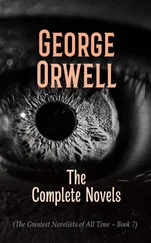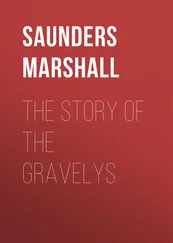The stupa is multileveled, terraced; people circumambulate on each level. Pigeon shadows flee across multiple planar surfaces, along with the shadows of thousands of prayer flags. Barefoot boys lug buckets of yellowish whitewash to the top level and sling these across the surface of the dome, leaving jagged yellow thunderbolts. The only sounds are birdsong and the occasional clanging of a bell and, in the far distance, a power saw.
I do lap after lap, praying for everybody I know. For me, this has been a tough year: A beloved uncle died, my parents’ house was destroyed by Katrina, a kindhearted cousin shipped off to Iraq, a car accident left my teenage daughter sobbing by the side of the road on a dark, freezing night, I’ve found myself loving my wife of eighteen years more than I’d even known you could love another human being — a good thing, except that it involves a terrifying downside: the realization that there must someday come a parting.
Today, at the stupa, it occurs to me that this low-level ambient fear constitutes a decent working definition of the human: A human being is someone who, having lived awhile, becomes terrified and, having become terrified, deeply craves an end to the fear.
All of this — the stupa, the millions of people who have circumambulated it during the hundreds of years since it was built (in Shakespeare’s time, while Washington lived, during the Civil War, as Glenn Miller played), the shops, the iconography, the statues, the tangka paintings, the chanting, the hundreds of thousands of human lives spent in meditation — all of this began when one man walked into the woods, sat down, and tried to end his fear by doing something purely internal: working on his mind.
As I’m leaving the stupa, a kid drags me into a little room to the side of the main gate. Inside are two massive prayer wheels. He shows me how to spin them. Three laps is recommended for maximum blessing. In one corner sits a midget in monk’s robes, praying.
“Lama,” my guide says as we pass.
On the second lap, he points out a collection of images of great Buddhist saints, stuck above a small window. Here is the Dalai Lama. Here is Guru Rinpoche, who first brought Buddhism to Tibet. Here is Bomjon, the meditating boy.
The photo shows a boy of about twelve: a chubby crew-cut smiling little guy, shy but proud, like a Little Leaguer, but instead of a baseball uniform, he’s wearing monk’s robes.
“Bomjon,” I say.
“You are very talent!” says my guide.
BAD AND GETTING WORSE
Back at the Hyatt, I meet Subel, my translator, a kindly, media-savvy twenty-three-year-old who looks like a Nepali Robert Downey Jr. We take a terrifying ride through Katmandu on his motorcycle to a darkened travel agency, where we buy plane tickets by candlelight; Katmandu is under a program called “load shedding,” which, in the name of conservation, cuts power to a different part of town every night. The agent processes our tickets sac-ramentally in the light from three red candles tilted on sheets of newspaper.
Given Nepal’s political situation, there’s something ominous about the darkened travel agency, a suggestion of bleaker conditions soon to come.
More than ten thousand Nepalis have died in the past ten years in an ongoing war between the monarchy and the Maoists. Over the past three years, the new king has basically canceled the burgeoning but inefficient democracy and seized back all power. A week after I leave, he will arrest opposition leaders, and the most serious attacks yet on Katmandu will take place.
Over dinner, Subel (like some prerevolutionary Russian intellectual, a Herzen or Belinsky, personally offended by the cruelty of his government) gets tears in his eyes telling me about a twenty-year-old Nepali woman who died in a distant airport, unable to get to the Katmandu hospital because the inefficient airline canceled all flights for three days straight; tells about the arrogant Nepali soldiers who pulled over two friends of his, singers, and made them sing on the street as the soldiers laughed at them. He doesn’t want to ever leave Nepal, he says, unless in doing so he can acquire a useful skill and come back and “make some differences.”
The country is scared, wired, suffering, dreading an imminent explosion that will take a catastrophically poor country and turn it into a catastrophically poor country in a state of civil war. In Katmandu it seems everybody knows about the meditating boy, follows news of him avidly, believes he’s doing what he’s said to be doing, and wishes him luck. They feel him, you sense, as a kind of savior-from-within, a radical new solution to festering old problems. Political pragmatism exhausted, they’re looking for something, anything, to save them.
A friend of Subel’s tells me he hopes the meditating boy will do “something good for this country,” meaning, to my ear, something good for this poor, beaten-down country, which I dearly love.
TO GET THERE, HEAD IN THE DIRECTION OF POOR
Next morning we fly to the southern village of Simra in a submarine-like plane that has, for a sun visor, a piece of newspaper taped to the windshield. The seats are webbed and metal-framed like lawn chairs, the floor made of carpetless dented metal. We pass, barely, over one-room farmhouses perched atop cartoonishly steep mountains, entire spreads consisting of just a postage-stamp-sized green terrace dug out of a gray mountainside. From Simra we take a jeep to Birgunj and spend a restless night in a Gogolian hotel where the bathroom lights buzz even when off, and I am perplexed by a mysterious panel of seven switches that never seem to control the same light twice.
Next morning we’re off to see the boy.
We head back through Simra by minivan and then beyond, through a swirl of the maddest poverty: Girls plod out of deep woods with stacks of huge leaves on their backs to feed some animal; a woman squats to piss, yards away from a muddy pond where another woman draws water; men pound metal things with other metal things; dirty kids are sniffed by dirty dogs as dogs and kids stand in trash.
After a couple of hours, we pull off into a kind of gravel staging area overhung with red welcome banners. On a large billboard — the only one I’ve seen all morning — a personified condom gives an enraptured young couple some advice out of its jauntily tilted receptacle tip: “Please, enjoy safe sex!”
“Is this it?” I say.
“This is it,” Subel says.
BUT STILL WE ARE NOT THERE
Beyond the staging area, the road goes single-vehicle, double-rutted. I try taking notes, but the road is too bumpy. CRWLFF! I write, FHWUED??
The jungle gets denser; a dry riverbed on the right disappears into the trees. Finally, we reach a kind of minivillage of crude wooden stalls. Boy-related postcards and framed photos and pamphlets are for sale, along with flowers and scarves to present as offerings. We leave the van and walk along a dirt road. Pilgrim-related garbage lines the ditches on either side. A TV on a rickety roadside table blares a Bollywood video: a woman so sexy she captivates a shipful of genial sailors. At a climactic moment, she drops backward into a giant cup of tea, causing a blind man to lose his treasured burlap sack.
A mile farther on, we leave our shoes in a kind of Shoe Corral, take a narrow path worn smooth by tens of thousands of pilgrim feet. The path passes through the roots of a large pipal tree hung with pictures of the boy. A quarter mile more and we reach a tree-posted sign in Nepali, requesting quiet and forbidding flash photography, especially flash photography aimed at the meditating boy. Beyond the sign, seven or eight recently arrived pilgrims stand at a gate in a barbed-wire fence, craning to see the boy while stuffing small bills into a wooden donation box mounted on the fence.
Читать дальше
